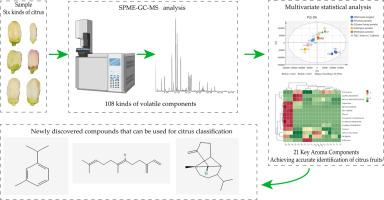Identification of different citrus varieties by SPME-GC–MS technique
IF 4.2
2区 农林科学
Q1 HORTICULTURE
引用次数: 0
Abstract
The objective of this study was to analyze the volatile components in the flower buds of six different citrus varieties. This analysis was performed using solid-phase microextraction-gas chromatography-mass spectrometry (SPME-GC–MS) to identify key substances for variety identification. Following the optimization of the SPME conditions, 108 volatile compounds were identified, and 21 key aroma components were screened. Of these, M-cymene, (E)-β- farnesene, and Tricyclo[4.4.0.02,7]decane,1-methyl-3-methylene-8-(1-methylethyl)-, (1R,2S,6S,7S,8S)-rel- were newly identified as key aroma components of citrus. Significant cultivar-specific differences were observed: Citrus limon (L.) Burm. f. cv. Lisbon had the highest d-limonene content (>50 %); Minneola tangelo was characterized by linalool (20.21 %) and thymol; and Guanxi honey pomelo was rich in β-myrcene (26.21 %). Principal component analysis, partial least squares discriminant analysis (PLS-DA), and hierarchical cluster analysis based on the Ward method were used together to accurately identify six citrus varieties. This study established a rapid and reliable volatile component fingerprint analysis method for authenticity identification and quality assessment of citrus varieties.

SPME-GC-MS技术鉴定柑橘品种
本研究的目的是分析6个不同柑橘品种花蕾中的挥发性成分。采用固相微萃取-气相色谱-质谱联用技术(SPME-GC-MS)鉴定品种鉴定的关键物质。通过优化SPME条件,共鉴定出108种挥发性化合物,筛选出21种关键香气成分。其中,m -聚伞花烯、(E)-β-法尼烯、三环[4.4.0.02,7]癸烷、1-甲基-3-亚甲基-8-(1-甲基乙基)-、(1R,2S,6S,7S,8S)-是新鉴定的柑橘主要香气成分。不同品种间存在显著差异:发热管。f .简历。里斯本的d-柠檬烯含量最高(50%);檀香的主要成分为芳樟醇(20.21%)和百里酚;广西蜜柚富含β-月桂烯(26.21%)。采用主成分分析、偏最小二乘判别分析(PLS-DA)和基于Ward方法的层次聚类分析,对6个柑橘品种进行了准确的鉴定。本研究建立了一种快速可靠的柑橘品种挥发性成分指纹分析方法,用于柑橘品种的真伪鉴定和品质评价。
本文章由计算机程序翻译,如有差异,请以英文原文为准。
求助全文
约1分钟内获得全文
求助全文
来源期刊

Scientia Horticulturae
农林科学-园艺
CiteScore
8.60
自引率
4.70%
发文量
796
审稿时长
47 days
期刊介绍:
Scientia Horticulturae is an international journal publishing research related to horticultural crops. Articles in the journal deal with open or protected production of vegetables, fruits, edible fungi and ornamentals under temperate, subtropical and tropical conditions. Papers in related areas (biochemistry, micropropagation, soil science, plant breeding, plant physiology, phytopathology, etc.) are considered, if they contain information of direct significance to horticulture. Papers on the technical aspects of horticulture (engineering, crop processing, storage, transport etc.) are accepted for publication only if they relate directly to the living product. In the case of plantation crops, those yielding a product that may be used fresh (e.g. tropical vegetables, citrus, bananas, and other fruits) will be considered, while those papers describing the processing of the product (e.g. rubber, tobacco, and quinine) will not. The scope of the journal includes all horticultural crops but does not include speciality crops such as, medicinal crops or forestry crops, such as bamboo. Basic molecular studies without any direct application in horticulture will not be considered for this journal.
 求助内容:
求助内容: 应助结果提醒方式:
应助结果提醒方式:


